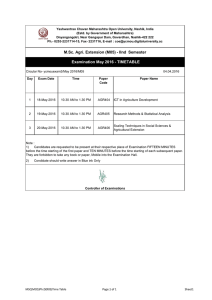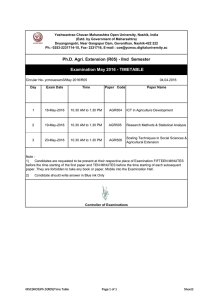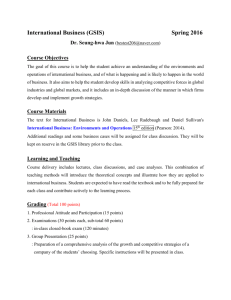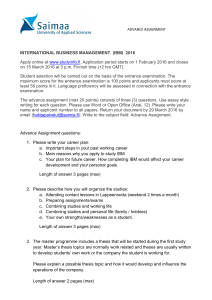E N . __________________
advertisement
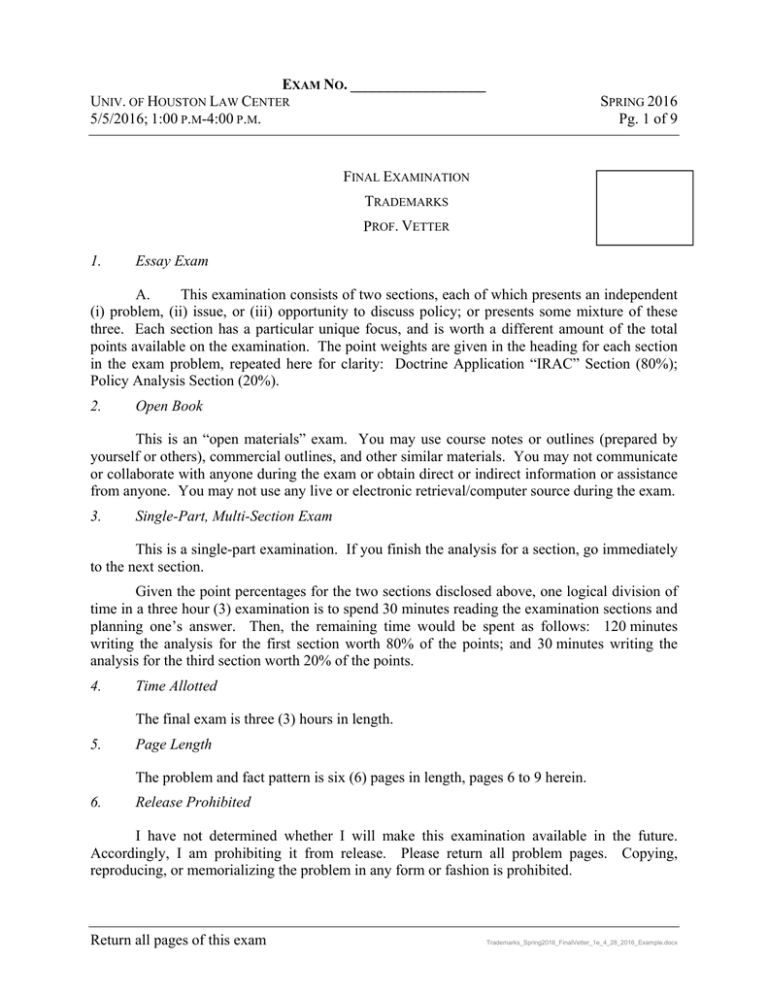
EXAM NO. __________________ UNIV. OF HOUSTON LAW CENTER 5/5/2016; 1:00 P.M-4:00 P.M. SPRING 2016 Pg. 1 of 9 FINAL EXAMINATION TRADEMARKS PROF. VETTER 1. Essay Exam A. This examination consists of two sections, each of which presents an independent (i) problem, (ii) issue, or (iii) opportunity to discuss policy; or presents some mixture of these three. Each section has a particular unique focus, and is worth a different amount of the total points available on the examination. The point weights are given in the heading for each section in the exam problem, repeated here for clarity: Doctrine Application “IRAC” Section (80%); Policy Analysis Section (20%). 2. Open Book This is an “open materials” exam. You may use course notes or outlines (prepared by yourself or others), commercial outlines, and other similar materials. You may not communicate or collaborate with anyone during the exam or obtain direct or indirect information or assistance from anyone. You may not use any live or electronic retrieval/computer source during the exam. 3. Single-Part, Multi-Section Exam This is a single-part examination. If you finish the analysis for a section, go immediately to the next section. Given the point percentages for the two sections disclosed above, one logical division of time in a three hour (3) examination is to spend 30 minutes reading the examination sections and planning one’s answer. Then, the remaining time would be spent as follows: 120 minutes writing the analysis for the first section worth 80% of the points; and 30 minutes writing the analysis for the third section worth 20% of the points. 4. Time Allotted The final exam is three (3) hours in length. 5. Page Length The problem and fact pattern is six (6) pages in length, pages 6 to 9 herein. 6. Release Prohibited I have not determined whether I will make this examination available in the future. Accordingly, I am prohibiting it from release. Please return all problem pages. Copying, reproducing, or memorializing the problem in any form or fashion is prohibited. Return all pages of this exam Trademarks_Spring2016_FinalVetter_1e_4_28_2016_Example.docx UNIV. OF HOUSTON LAW CENTER 5/5/2016; 1:00 P.M-4:00 P.M. 7. TRADEMARKS, SPRING 2016 Pg. 2 of 9 Other Instructions If using a blue book, please write on only one side of the page. Put your Exam Number on each blue book. Please bring a printed copy of the assigned casebook to the examination, for the assigned parts of the book covered in class. Besides the course casebook, also bring the following to the examination in printed form: (i) the Lanham Act; and (ii) the course overheads. Finally, please bring a dictionary. The law applicable to this examination is the law covered in this course from: the assigned reading from the casebook and any assigned supplement, and additional law (if any) provided in the course overheads (collectively, the “Materials”). In my upper level Intellectual Property courses the Materials also include the primary statutory, regulatory, or treaty-based provisions relating to the assigned reading materials. Be sure to answer all questions on the basis of the law provided in the Materials.a Write an analysis for each of the issue(s) raised by the facts or information enumerated in the examination sections. At the end of each section the focus or “call” of the question is given in a short paragraph enclosed in a rectangle. Organize your written answer logically by the sections of the examination. Your written answer does not need a general introduction. Proceed immediately to analyzing the issues, problems or questions in each section. The sections vary in the degree to which they suggest incorporating policy analysis. One section, the last, overtly suggests policy analysis. Another explicitly suggests traditional IRAC analysis: Issue, Rule, Application and Conclusion. Organize your answer for each section in a logical, orderly way. In most cases that means you won’t organize your answer explicitly using the questions/assignments in the rectangle as headings for your answer. Your answer should address the questions/assignments in the rectangle containing the “call” of the question, but typically the questions/assignments themselves do not make a good organizational vehicle. The policy oriented section is designed to allow one to employ some of the various policy arguments that arose during the course. These arguments include, without limitation: the purpose of trademark law; the effects and causes of branding; efficacy, reliability, fairness and justification of trademark law; and the impact of all this on individuals, companies, and a There may be some situations where the Materials provide alternative rules or tests for resolving a specific legal issue. In these instances, the “majority” rule is the rule or test relied on by the majority in a primary case in the casebook/supplement. Any other different tests or rules, (which could be multiple) whether mentioned by the majority opinion, offered in a dissent, described in the notes to the case, or given in the overheads, are alternative or “minority” rules. This instruction does not necessarily mean that issues exist in this examination requiring the application of alternative or minority rules. And, it may or may not be necessary to analyze any or all such alternative or minority rules depending on other specific examination instructions and/or the facts provided. Return all pages of this exam Trademarks_Spring2016_FinalVetter_1e_4_28_2016_Example.docx UNIV. OF HOUSTON LAW CENTER 5/5/2016; 1:00 P.M-4:00 P.M. TRADEMARKS, SPRING 2016 Pg. 3 of 9 multinational enterprises (MNEs). This listing, however, is not necessarily a good way to organize the analysis. A productive organization of the analysis depends on the context of the problem(s), dispute(s) or question(s) posed in the policy-oriented section. Application and deployment of these and other arguments is the emphasis of the “policy” section. Some may view the question(s) in the “policy” section as having two “sides” along political or other ideological lines. Even assuming this view, however, an answer does not earn points by picking the “right” or “best” side of the issue, but rather by effectively marshalling arguments for the facets of the issue. The “policy” section, however, is not completely divorced from the doctrine studied in the course. Question(s) in the “policy” section may require familiarity with or recognition of the doctrine studied in the course in the context of specific course cases and examples. For the IRAC section, write a short analysis for each of the issues raised by the facts enumerated in the examination question, based only on the law from the Trademarks course. The analysis should communicate the following as briefly as possible based on the facts available: (i) discuss the arguments, positions and intellectual property rights that the plaintiff/initiator should assert, or has asserted,b against the defendant(s)/respondent(s); (ii) evaluate the arguments and substantive merits from each side’s perspective, articulating defenses and counter-arguments each should/might assert; (iii) assess the strength of each party’s arguments; and (iv) determine for each issue who is likely to prevail and explain why. Your written answer, however, should not be organized according to these four points. Rather, for each issue, your analysis should communicate the issue, and then state/apply the law to the issue’s facts (applying counterarguments as well), and then conclude on the issue. An exception to this is that there is no need to restate a legal test that has already been stated; simply refer to the previous statement of the rule. For example, if there is a second trademark likelihood of confusion issue under the multifactor test, and you have already related the multifactor test elements for an earlier issue, you can abbreviate your analysis by directly applying the law to the facts and concluding. Another way to say this is that if a second issue arises where there is a need to apply a legal test already related and discussed, you may analyze the second issue by exception, i.e., discussing the differences in application and outcome. If you believe that there are any additional critical yet unsupplied facts that would materially impact the outcome of a particular issue, you should note what such facts would be. In such case, briefly describe how such critical facts might impact the outcome, i.e., indicate at b The examination question may be written in such a way that certain issues are clearly “in” the case/dispute because they have been asserted by either party. You should analyze these issues, but there may be other issues to be analyzed as well because the examination question is silent about whether they have been, will, or will not be asserted by either side. In addition, the examination question may also indicate that certain other possible issues are “out” and not to be analyzed because the parties disclaim certain issues or protections. Return all pages of this exam Trademarks_Spring2016_FinalVetter_1e_4_28_2016_Example.docx UNIV. OF HOUSTON LAW CENTER 5/5/2016; 1:00 P.M-4:00 P.M. TRADEMARKS, SPRING 2016 Pg. 4 of 9 most one and only one differing result that would ensue from different reasonable factual assumptions about such unsupplied facts.c As a general matter, discuss any invalidity/protectability issues before any infringement issues. For example, if analyzing a mark, discuss any invalidity issues before infringement. Your written answer does not need a general introduction. Proceed immediately to analyzing the issues. The location of final jurisdiction and/or venue for the expected case/dispute is not a part of the analysis.d Apply only the majority rules from the applicable law. Thus, your analysis can ignore any significant outcome-determinative differences in majority/minority rules and need not supply/apply minority rules. Probably the only way in which minority rules or dissents are relevant is that they sometimes provide inspiration for counterarguments. You should analyze clearly presented (either explicitly or by the facts) infringement issues in the case/dispute even if your analysis determines that the relevant item of intellectual property is invalid, unenforceable or not properly the subject matter of protection. An example of this principle in trademark law is the assertion of product shape/design as a mark, but where the trademark defendant/respondent might have a functionality defense. In a real court opinion, if the court holds that the defendant/respondent wins on the functionality issue, the court would typically not analyze the likelihood of confusion test to determine if the accused product shape infringes the product shape/design allegedly functioning as a mark. Your analysis, however, should evaluate both the functionality defense and infringement if clearly presented: even if you conclude that the shape/design is functional and thus not the proper subject matter of protection as a mark, go on to analyze whether the likelihood of confusion test is met for infringement of the shape/design mark. Similar examples exist within other areas of intellectual property. In this vein, some intellectual property embodiments may have multiple issues of invalidity charged against them. Each invalidity issue raised by the problem’s facts should be evaluated even if your analysis determines that a right is invalid due to one of the raised issues. Finally, for the following doctrinal areas of trademark law, use the following as the authoritative “law of the class.” For each item listed below, the case law covered in the course is still relevant. This is true even if the case law is from a different circuit with a slightly different approach to a test such as the likelihood of confusion multifactor test. c Please note that if you find yourself discussing alternative outcomes for supposedly critical yet unsupplied facts for every issue you analyze, you are probably engaging in too much analysis of such alternative outcomes. d Despite this jurisdictional orientation, the issues in this examination do not include jurisdictional and procedural issues, but rather focus on the substantive trademark law and rights from the course materials. In addition, you are to analyze and discuss the probable ultimate outcomes under the substantive law studied. Do not analyze any intermediate standards, such as likelihood of success in obtaining a preliminary injunction. Return all pages of this exam Trademarks_Spring2016_FinalVetter_1e_4_28_2016_Example.docx UNIV. OF HOUSTON LAW CENTER 5/5/2016; 1:00 P.M-4:00 P.M. TRADEMARKS, SPRING 2016 Pg. 5 of 9 For likelihood of confusion, use the eight factors given on overhead 157, but if any facts are given triggering the other factors listed on overhead 158, apply those other additional factors only if raised by such facts. For the characterization of a mark as either suggestive or descriptive, use any one or more of the four tests given 19-21 in the casebook, part 1, based on the facts provided that might trigger one or more of those tests. For the multifactor test to determine if a mark has developed secondary meaning, use the factors for the Second circuit as given on page 41 in the casebook, part 1. For the characterization of a mark as either generic or descriptive, apply at least both tests discussed on page 57 in the casebook, part 1: (i) the “who-areyou/what-are-you” test; and (ii) the “common descriptive name” test. For non-word marks that have the legal capability to be inherently distinctive, use the Seabrook factors for that inquiry. For functionality doctrine, the law of several circuits is given across pages 187 to 208, casebook part 1. Among these opinions, apply ninth circuit law. For a good statement of the overarching framework for functionality doctrine, see pages 219-220, casebook part 1. The Dawn Donut rule is in effect. The doctrine of Well Known marks is in effect. The opinion in In re Tam is not in effect. These areas within trademark law will not be covered on the examination: Although there was a class session on the details of remedies and damages, so do not discuss these items. Certification marks and collective marks HONOR CODE: Turning in an examination answer to this final examination is deemed to be a pledge under the Law Center honor code that the exam taker has complied with the honor code in all respects in relation to this examination. (the examination problem starts on the next page) Return all pages of this exam Trademarks_Spring2016_FinalVetter_1e_4_28_2016_Example.docx EXAM NO. __________________ UNIV. OF HOUSTON LAW CENTER 5/5/2016; 1:00 P.M-4:00 P.M. A. 1. SPRING 2016 Pg. 6 of 9 Doctrine Application “IRAC” Section (80%) The Background Rhonda Balm, M.D., has been developing skin-care salves.1 Balm’s lab is a corner room on the second floor of her office building.2 Balm obtained U.S. patent protection for an item as described below. One embodiment disclosed in Balm’s patent is as follows: Balm’s embodiment: Balm markets her embodiment3 (shown above) under the name HappyFrac® to manufacturers of moisturizers and to companies that build machines for such manufacturers. John Duck makes and sells a product he calls SaddFrac®.4 It fractifies saddle grease, which is used to moisturize and soften leather saddles. Duck’s product, which he sells to saddle grease manufacturers,5 is as follows: 1 The word “salve” means: an analgesic or medicinal ointment. 2 Balm operates a dermatology clinic on the first floor of the building. 3 Customers use Balm’s device to fractify skin-moisturizer by pumping the moisturizer through the tube under pressure. The plates, by passing the moisturizer through their openings, fractify the moisturizer. 4 Balm and Duck’s word marks are each federally registered and incontestable. 5 Fifty percent of Balm’s moisturizing manufacturing customers also make saddle grease and purchase Duck’s SaddFrac product. These common customers, however, comprise only twenty percent of Duck’s customers. Return all pages of this exam Trademarks_Spring2016_FinalVetter_1e_4_28_2016_Example.docx TRADEMARKS FINAL EXAMINATION, SPRING 2016 Duck’s SaddFrac product: 6 2. The Dispute Balm sues Duck under trademark law. During the proceedings additional items are discovered and/or arguments, admissions and stipulations are made: (i) Balm asserts that the embodiment’s face pattern is a product shape/design mark infringed by Duck. Balm also asserts that SaddFrac infringes her mark HappyFrac, offering a survey showing that 50% of her customers who don’t purchase SaddFrac (and who also had never heard if it) thought SaddFrac would be her product when shown the mark. (ii) Duck’s SaddFrac marketing literature and advertising regularly includes the phrase: “happily frac your products with SaddFrac.” Common parlance in the relevant customer group is to use the shorthand “frac” for fractification. (iii) At a recent trade show, with both Balm and Duck’s customers in attendance, Duck played an advertisement on a screen displayed prominently above its booth. The voice-over said: “In the equestrian7 market, only one product belongs in the winner’s circle.” The audio-visual display showed the Balm embodiment plate with “HappyFrac” written on it, sitting on the top of a horse’s rear end. The plate rolls off the horse via its tail, onto the ground, and rolls out of the winner’s circle, lodging itself in a pile of horse manure, at which time the “HappyFrac” wording dissolves and runs down into the manure like watercolor paint in the rain.8 6 This picture (and the one above of the Balm embodiment) shows a perspective view: the Duck tube is round and so are the plates, and the plates are fixed at a 90º angle from the tube axis. Duck developed SaddFrac completely independently, after Balm’s patent issued, and after Balm’s HappyFrac word mark became famous in the market. 7 The word “equestrian” means: of or relating to horseback riding or horseback riders. 8 Balm disclaims bringing any actions based on dilution by blurring. 7 TRADEMARKS FINAL EXAMINATION, SPRING 2016 (iv) Sometime after Duck’s SaddFrac mark is federally registered, Balm begins selling saddle polish under the name SapFree. While saddle grease is used to moisturize and soften leather saddles, saddle polish is used on the metal parts on the saddle. Balm states the following in an email to his business manager: “I want all those customers who love SaddFrac to think our polish is from the same source so we can more quickly build up sales in the market.” What action(s) should Balm bring against Duck, and what is the likely analysis and outcome of that legal action(s)? What action(s) should Duck bring against Balm, and what are the likely analysis and outcomes of those legal action(s)? 8 TRADEMARKS FINAL EXAMINATION, SPRING 2016 B. Policy Analysis Section (20%) The policy proposer is concerned about the power of dilution law. He is concerned that dilution rights give brand owners too much power to control the user of words and symbols in the market and in culture. He leads an effort to revise dilution law in the U.S. with the following proposals: (i) dilution will only apply to word marks; (ii) dilution by blurring will only apply for nearly-identical marks used by the defendant; (iii) dilution by tarnishment will apply for similar or identical marks used by the defendant; and (iv) either type of dilution will only apply against non-competitors. Critique from a policy and legal perspective the proposal. Would you endorse it, reject it, or implement it in altered form?, and if so, how would you alter it? Will it solve, in part or in whole, at a policy level or a legal level, the problem(s) that concern the proposer? END OF EXAMINATION 9
